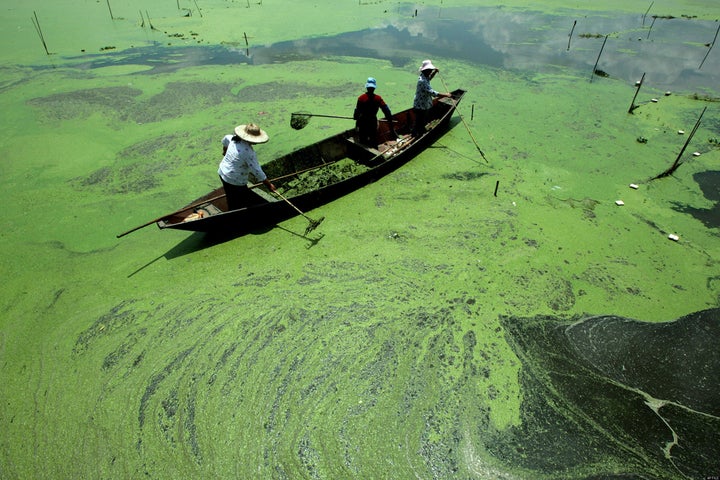
NASA's Earth Observatory's "Image of the Day" blog is like a high-grade morning fix for nerdy armchair geographers (ahem). It takes a certain mindset to get excited each morning by an Uruguayan rainfall anomaly map or a satellite image of the Indus River. Take a step back, however, and the vast archive of images reveals a portrait of some of the most pressing environmental issues of the day. The stories told by the archive can reflect emergencies (the liberal sprinkling of Gulf of Mexico oil slick images since April), reliable seasonal changes (satellite images of floods dominate during the spring and fall months), or common yet dramatic events (you can always count on images of active volcanoes puffing away, usually within spitting distance of a vulnerable city or village).
Every once in a while, however, there's an image that arrives out of the blue, like on July 17th when I started the morning with an alarming map of the world's aquatic dead zones.
With the Gulf of Mexico's oil gusher dominating the headlines since April, it's been easy to forget that agricultural runoff infused with fertilizers, and sewage from many treatment plants, has continued to wind its way through small streams and into the Mississippi River, then ultimately reaching the gulf.
All of those excess nutrients lead to massive algal blooms and low dissolved oxygen levels, leaving large swaths of the gulf virtually uninhabitable for most marine life. Hence, "dead zones."
You've probably heard of this phenomenon before, at least in the gulf. But even a brief glance at that NASA map - the high-resolution version really helps to bring out the devastation - reveals a far more global problem:
- Nearly the entire east and gulf coasts of the United States are dotted with dead zones of various sizes and intensities, and the Pacific Northwest coast may be experiencing a large, "irreversible" dead zone more attributable to rising water temperatures due to climate change than polluted runoff.
- Both the North Sea and Baltic Sea are unfortunately well-represented on the map; the Baltic in particular is home to seven of the world's ten largest dead zones.
- The Yangtze River carries fertilizers from China's agricultural interior to the East China Sea, just as the Mississippi River carries excess fertilizers to the Gulf of Mexico. China has over the past couple of decades become the world's largest consumer of fertilizers, and not coincidentally the dead zone in the East China Sea now rivals that in the Gulf of Mexico.
All told, there are over 400 dead zones worldwide, affecting an area of more than 245,000 square kilometers, a number that has increased exponentially since the 1960s. These dead zones can now be included with the damaging quartet of overfishing, habitat loss, harmful algal blooms and acidification as the most pressing threats to the health of the world's oceans. The only real solution is to reduce the amount of nitrogen and phosphorous from fertilizers entering the world's estuaries, but that's not an easy feat in the age of industrialized agriculture and aggressive plans for corn-based ethanol.
Decisions made by agricultural and energy interests will continue to have an increasingly devastating impact on water quality throughout the world. I'd like to think that we can get everyone, including agribusiness, biofuel entrepreneurs and coastal managers, in the same proverbial room to create a better plan. But in the meantime I should probably gird myself for another future morning that begins with a newly-updated and still-distressing dead zone map.
I'd rather see a puffing volcano.
Originally published at Ecocentric.